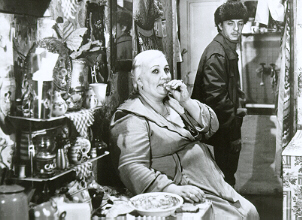FILM NOTES
FILM NOTES INDEX
NYS WRITERS INSTITUTE
HOME PAGE

(Russian, 1989, 153 minutes, b&w and color, 35mm)
Directed by Kira Muratova
Starring:
Olga Antonova, Sergie Popov, Galina Zakhurdayeva
In Russian with English Subtitles
The
following film notes were prepared for the New York State Writers
Institute by Kevin Jack Hagopian, Senior Lecturer in Media Studies
at Pennsylvania State University:
 On its release in 1989, Kira Muratova's THE ASTHENIC SYNDROME won for itself a dubious honor: at the very moment when the Soviet government was straining to become more open, the film was censored by the state, which threatened not to allow release of the film at all. What marked THE ASTHENIC SYNDROME for disapproval at the end of the Soviet Union's political provincialism, was, perversely, the film's very universality. For, as the Soviet Union metamorphosed into Russia, a few artists like Muratova stood ready to make the nation aware that its problems were not over, because those problems struck deeper than economics. In ASTHENIC SYNDROME, the nation appears paralyzed by a profound unwillingness to communicate, by a fearsome, all-consuming rage, and by a will to self-destruction. It is a picture of a society in chaotic breakdown. Muratova was heartily criticized for a needlessly gloomy outlook at a time when it seemed that a fragile optimism was the only thing that could sustain change against the forces of reaction in the Soviet Union. What narrow-minded deputies of the state could not see, however, was the vastly hopeful undertone of the film, which established new spiritual links between Russians and all of humanity, regardless of ideology.
On its release in 1989, Kira Muratova's THE ASTHENIC SYNDROME won for itself a dubious honor: at the very moment when the Soviet government was straining to become more open, the film was censored by the state, which threatened not to allow release of the film at all. What marked THE ASTHENIC SYNDROME for disapproval at the end of the Soviet Union's political provincialism, was, perversely, the film's very universality. For, as the Soviet Union metamorphosed into Russia, a few artists like Muratova stood ready to make the nation aware that its problems were not over, because those problems struck deeper than economics. In ASTHENIC SYNDROME, the nation appears paralyzed by a profound unwillingness to communicate, by a fearsome, all-consuming rage, and by a will to self-destruction. It is a picture of a society in chaotic breakdown. Muratova was heartily criticized for a needlessly gloomy outlook at a time when it seemed that a fragile optimism was the only thing that could sustain change against the forces of reaction in the Soviet Union. What narrow-minded deputies of the state could not see, however, was the vastly hopeful undertone of the film, which established new spiritual links between Russians and all of humanity, regardless of ideology.
The film is not a political critique of a nation, but an essay on divisions. Muratova makes difference the structural heart of her film, harshly splitting the film into a short black-and-white segment, and a much longer color passage. At even more basic levels, THE ASTHENIC SYNDROME is a fragmented, even shattered, text. Its editing initially seems desultory, occasionally random, as Muratova forces powerful thematic comparisons by pounding odd, incongruous images against one another. Laughter at a graveside, a bus carrying only one passenger--paradoxes are heaped on one another in a film whose narrative is so loaded with digressions that its forward direction becomes all but stalled. Muratova's uncompromising stylistic choices are designed to create a structured mosaic of life in a land that was itself a noisy bricolage of the old and the new, a film that features the death rattles of Stalinism even as it fears the dubious enthusiasms of Reaganism. Destruction is the operative concept in the film, whether the self-destruction of the self, the community, or the seemingly willful destruction of the remains of Soviet society. The entire film is a drama of contestation; every crowd on the screen fights and squabbles, mirroring the ongoing confrontation in the Soviet Union between the forces of retrenchment and those of change, a drama that was being enacted in the streets of every town during the stormy first release of THE ASTHENIC SYNDROME.
THE ASTHENIC SYNDROME is the story of "Natasha" (Olga Antonova), and her psychological pilgrim’s progress through a culture in disarray. Resolutely anti-linear, the film is related to the angst-ridden confessions of directors such as Andrei Tarkovsky, but Muratova's uncompromising rage sets this work apart as one of revolutionary anger and expressiveness; her characters hold nothing back, and her film is, as well, a passionately-felt, screaming catharsis. For Russian audiences, it proved harrowing. The notion of modern existence as a sickness, a “syndrome,” however, is a one that has resonance not only in the formerly gray bastions of communism, but in the increasingly alienated West, where the multiple joys of an advanced consumer lifestyle have failed to halt an encroaching sense of ennui.
 Soviet authorities claimed that their refusal to grant permission to Screen the film was due to an incredibly obscene monologue near the end of the film, and nudity elsewhere in the film. The monologue in question is delivered in "mat," a harsh, scatological slang. The stalemate was broken when the Union of Filmmakers essentially purchased the exhibition rights to the film from the state, although, to this day, screenings of Muratova's masterpiece are comparatively rare. But the attack on THE ASTHENIC SYNDROME showed just how slowly the thaw was coming to the Soviet Union, for this was yet like many other repressive regimes, where a still-monolithic, still-powerful state could feel besieged by a single work of art.
Soviet authorities claimed that their refusal to grant permission to Screen the film was due to an incredibly obscene monologue near the end of the film, and nudity elsewhere in the film. The monologue in question is delivered in "mat," a harsh, scatological slang. The stalemate was broken when the Union of Filmmakers essentially purchased the exhibition rights to the film from the state, although, to this day, screenings of Muratova's masterpiece are comparatively rare. But the attack on THE ASTHENIC SYNDROME showed just how slowly the thaw was coming to the Soviet Union, for this was yet like many other repressive regimes, where a still-monolithic, still-powerful state could feel besieged by a single work of art.
— Kevin Hagopian, Penn State University
For additional information, contact the Writers Institute at 518-442-5620 or online at https://www.albany.edu/writers-inst.